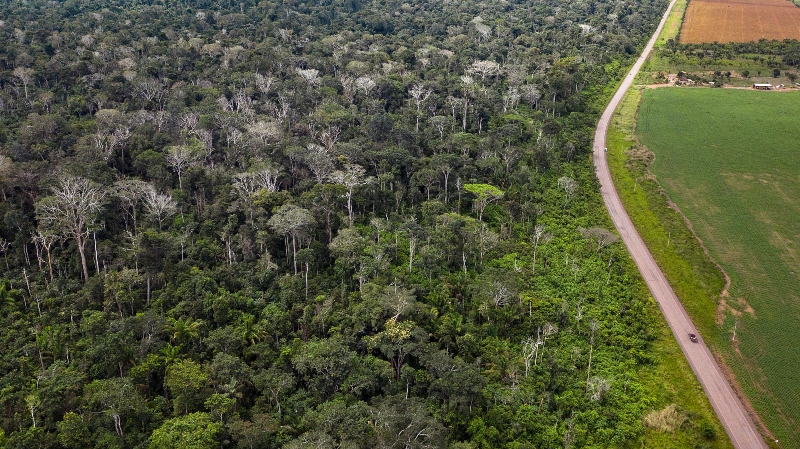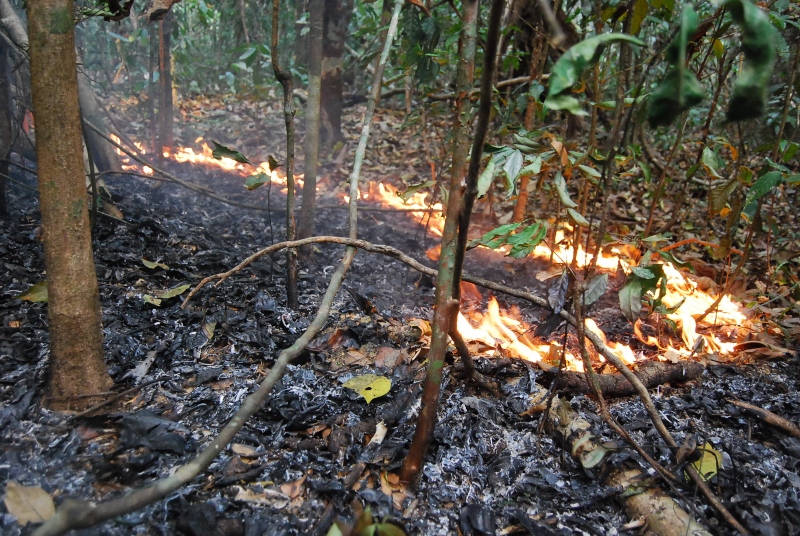Research proves that droughts and fires change the vital role of the Amazonian Forest
Research proves that droughts and fires change the vital role of the Amazonian Forest
In the areas analyzed there were billions of trees lost and large amounts of carbon emissions
Triggered by the 2015-16 El Niño, extreme drought and associated wildfires caused the death of around 2.5 billion trees and emitted 495 million tonnes of CO2 from an area that makes up just 1.2 per cent of the entire Brazilian Amazon rainforest, and 1 per cent of the whole Amazon forest biome. That means that when the forest, whose vital role is sequestering carbon into plants, is disturbed by fire and degradation, it can be one of largest sources of greenhouse gas emissions of the planet.
The discovery was revealed in the paper "Tracking the impacts of El Niño drought and fire in human-modified Amazonian forests" , which has been published by PNAS (Proceedings of the National Academy of Sciences of the United States of America) this week. The study, which was led by an international team of scientists in the scope of the Sustainable Amazon Network (RAS) -- a research consortium coordinated by Embrapa and other national and international institutions -- and project partners, was held before, during and after the El Niño drought in 2015 and early 2016.
FireIn normal circumstances, because of high moisture levels, the Amazon rainforest does not burn. However, extreme drought makes the forest temporarily flammable. The fire induced by human action, in those circumstances, can become uncontrollable and cause wildfires. |
The study found that the plants in forests affected by the climate event and by the wildfires induced by anthropogenic action kept dying at above-normal rates for up to three years, releasing more carbon dioxide into the atmosphere. Dr Erika Berenguer, from Lancaster University and the University of Oxford (United Kingdom) and lead author of the paper, states that the findings have significant implications for global efforts to control the atmospheric carbon balance.
"Our results highlight the enormously damaging and long-lasting effects fires associated with climate events can cause in Amazonian forests, an ecosystem that did not co-evolve with fires and degradation as regular pressures", the scientist explains.

Only a third of the CO2 emitted was recovered
Upon examining the Amazonian epicentre of the El Niño, in Brazil's Lower Tapajós riverside, an Eastern Amazonian area, the scientists found the damage lasts for multiple years. In practice, three years after the drought and due to wildfires in the region, only around a third (37%) of carbon emissions were re-absorbed by plant growth in the forest.
Another research result is the total carbon emissions from the drought and fires in studied region alone were higher than a whole year’s deforestation within the entire Amazon. In three years 495 million tonnes of CO2 were emitted from an area that makes up slightly more than 1% of the Brazilian Amazon region. "This represents more than the world’s worst polluting countries’ yearly carbon emissions – exceeding the emissions of developed countries such as the UK and Australia," Berenguer exemplifies.
The biologist Joice Ferreira, a researcher from Embrapa Eastern Amazon (Belém,PA), one of the authors of the study, explains that the forest is an important carbon sink in normal conditions. “What makes the forest become a source of emissions is the occurrence of degradation and fire”, she comments.
She stresses that according to weather forecasts, extreme droughts will become more common and, so far, the long-term effects of those events in the Amazon rainforest, and particularly in the forests disturbed by activities like illegal logging and slash-and-burn, were to a large extent unknown.
Loss of trees was larger in forests affected by human action
To reach the study results, the scientists gathered data by regularly revisiting 21 plots in the Western Amazon across a mixture of primary forest (undisturbed forests), secondary forest (re-growing after clearance for agriculture) and forests where people have selectively logged. The results from these plots were then extrapolated to the region.
The study showed that the loss of trees was much worse in secondary and other human-disturbed forests than in primary forests. The researchers found that trees and plants with lower wood density and thinner barks were more prone to dying from the drought and fires.
The researchers estimate that around 447 million large trees (greater than 10cm Diameter at Breast Height) died, and around 2.5 billion smaller trees (less than 10cm DBH) died across the Lower Tapajós region. “The combination of drought and fire was significantly bigger in the forests modified by human action. The carbon emissions of the forests burnt by wildfires were almost six times higher than the forests affected only by droughts”, states professor Jos Barlow, from Lancaster University.

Technologies help to anticipate and minimize risks
For professor Barlow, these findings highlight how interference by people can make the Amazon forests more vulnerable and underline the need to reduce illegal logging and other large-scale human disturbances of forests in the Amazon, as well as investments in fire-fighting capabilities in the Amazon.
The researcher Joice Ferreira, from Embrapa, indicates that Brazil already has technology and solutions to anticipate droughts and map fire risks every year. “It is possible to elaborate maps of fire risks based on weather conditions and on easily accessible data, including through remote sensing, such as population density, number of agricultural areas, size of deforested areas, and others”, the scientist states. She also adds that these maps can be used to perform risk management, with more rigid rules where there is higher risk.
"The results highlight the need for action across different scales. Internationally, we need action to tackle climate change, which is making extreme droughts and fires more likely. At the local level, forests will suffer fewer negative consequences from fires if they are protected from degradation”, Barlow concludes.
Ana Laura Lima (MTb 1268/PA)
Embrapa Eastern Amazon
Press inquiries
amazonia-oriental.imprensa@embrapa.br
Phone number: +55 91 99110-5115
Lancaster University
Press inquiries
i.boydon@lancaster.ac.uk
English version: Lancaster University & Mariana Medeiros (13044/DF)
General Secretariat
Further information on the topic
Citizen Attention Service (SAC)
www.embrapa.br/contact-us/sac/

